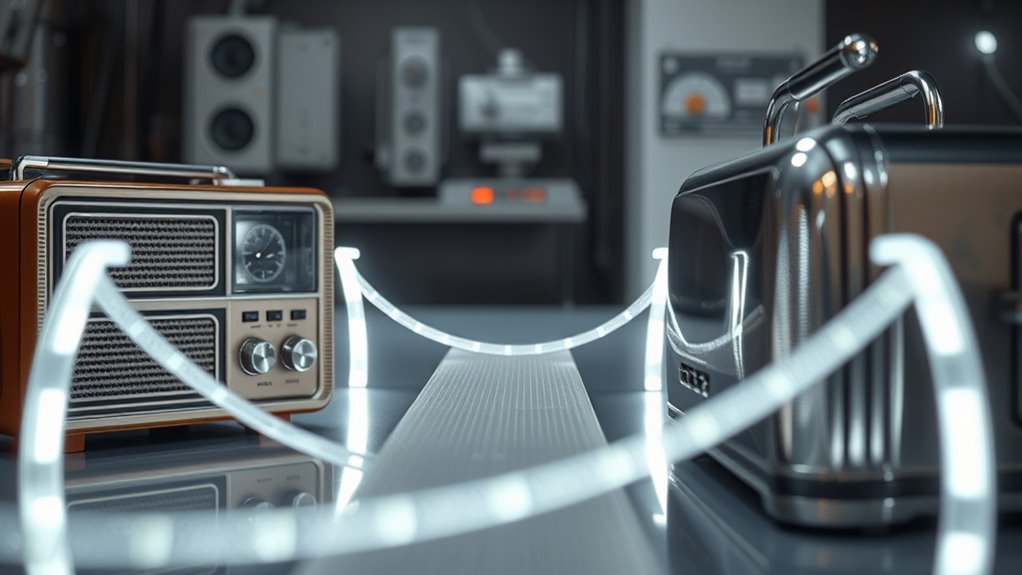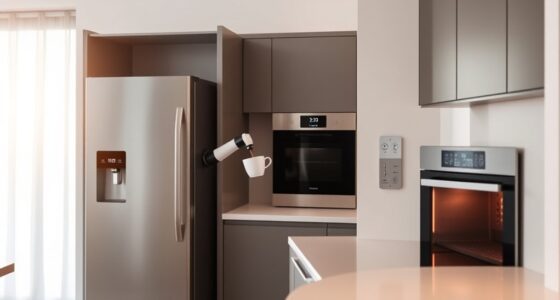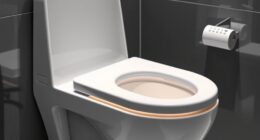Matter bridges help you connect older appliances to your smart home ecosystem, supporting protocols like Zigbee, Z-Wave, and more. They translate signals so your legacy devices can communicate seamlessly with new technology, improving compatibility and control. Expect some setup challenges and variations in features depending on the device and firmware. With ongoing advancements, future bridges will be even smarter, making integration easier. Keep exploring to learn all the details you need for a smooth experience.
Key Takeaways
- Matter bridges connect legacy devices like Z-Wave or Zigbee to modern Matter ecosystems, enabling seamless communication.
- They translate protocols and data formats, supporting compatibility across different smart home standards.
- Setup typically involves QR codes or scanning; network security and firmware updates are essential for reliable operation.
- Compatibility limitations include incomplete feature support and firmware variability among older devices.
- Future developments aim for broader protocol support, improved translation, and enhanced security for legacy appliance integration.
Understanding the Role of Matter Bridges in Smart Homes
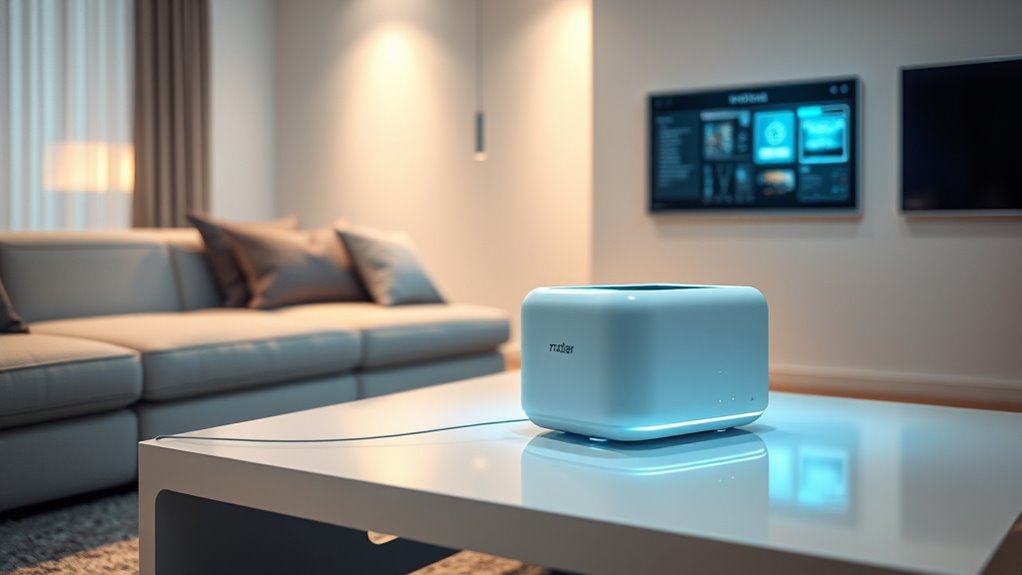
Matter bridges play an essential role in connecting your existing smart devices with the latest smart home technology. They act as translators, enabling devices from different manufacturers to communicate seamlessly, even if they don’t natively support the Matter standard. This means your older appliances can stay functional and integrated without needing replacement. They connect non-Matter protocols like Zigbee and Z-Wave to the Matter ecosystem, allowing older devices to be controlled alongside newer ones. Matter bridges simplify setup and control by consolidating multiple protocols into a single, user-friendly interface. They also improve efficiency by integrating legacy devices into modern ecosystems, eliminating the hassle of managing multiple apps. Additionally, by using the secure Matter protocol, these bridges enhance your smart home’s security. As cyber threats increase, AI security measures can help protect smart home networks from vulnerabilities. Integrating legacy devices through matter bridges ensures you maximize your existing investments while embracing new technologies. Overall, they help you maintain compatibility, streamline management, and future-proof your smart home investments, making your experience more cohesive and secure.
Types of Protocols Supported by Matter Bridges

Supported wireless protocols form the backbone of how Matter bridges connect and communicate with legacy devices. Matter natively supports Wi-Fi, Ethernet, and Thread, providing reliable, IP-based communication. Bluetooth plays a key role mainly during device commissioning and setup, ensuring quick and secure pairing. Many bridges translate protocols like Zigbee, Z-Wave, EnOcean, DALI, KNX, and Loxone, making non-Matter devices compatible with modern ecosystems. These bridges identify legacy devices via clusters and endpoints, mapping attributes to Matter models for seamless integration. Protocol translation enables devices across different standards to work together smoothly. By supporting diverse protocols, Matter bridges help you unify your smart home, bridging the gap between legacy appliances and the latest smart technology. Compatibility is essential for ensuring a smooth transition and integration experience, especially considering the variety of protocols involved.
How Protocol Translation Enhances Device Compatibility
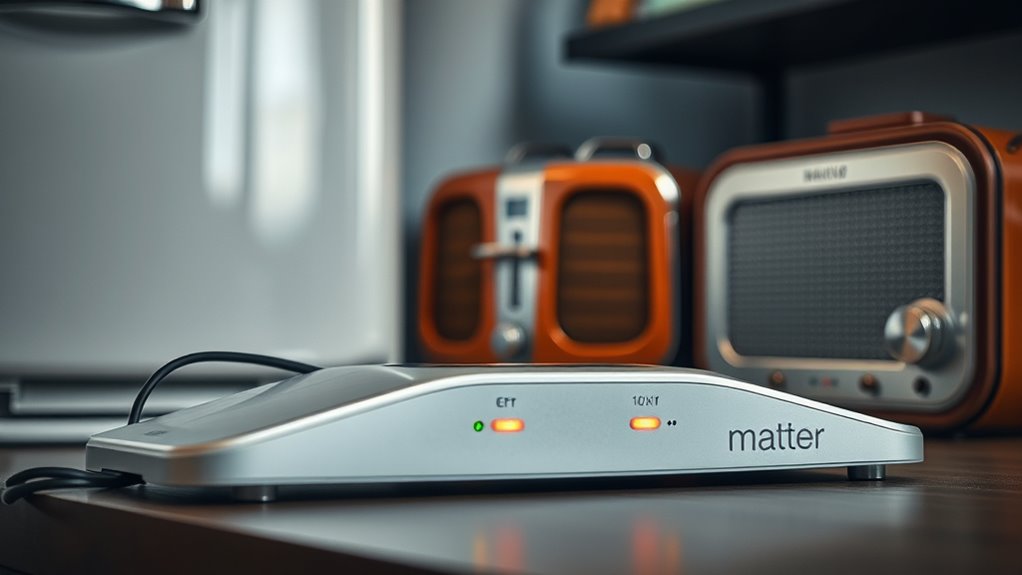
Protocol translation plays a crucial role in making legacy devices compatible with modern smart home systems by converting commands and data formats between different standards. It allows non-Matter devices, like Zigbee or Z-Wave, to appear as virtual or bridged devices within the Matter ecosystem, enabling seamless control. The bridge translates protocol-specific commands at the application layer, ensuring that your legacy devices respond correctly to Matter controllers. It also abstracts security, encryption, and communication differences, so you don’t have to worry about incompatible protocols. During device discovery, the bridge identifies and represents each legacy device as a Matter endpoint, maintaining a unified view. This process ensures that even older, proprietary devices integrate smoothly, expanding your smart home’s compatibility without replacing existing appliances. Additionally, high refresh rates in communication protocols help improve the responsiveness and reliability of device control within the system. Effective protocol translation relies on a clear understanding of communication standards and their interoperability features to ensure seamless device integration.
Key Technologies Powering Matter Bridge Functionality

The key technologies powering Matter bridge functionality rely heavily on robust hardware and software integration to guarantee seamless communication between legacy devices and the modern smart home ecosystem. You’ll find dual-core MCUs embedded in these bridges, supporting protocol translation and running the Matter stack efficiently. Ethernet or Wi-Fi modules enable reliable network connectivity, while security features protect your data. Some bridges use vendor-specific operating systems to interface with legacy devices and present them as Matter endpoints. Software components like the Matter stack and protocol translators ensure interoperability across protocols such as Zigbee, Z-Wave, and Bluetooth Mesh. Additionally, MQTT brokers facilitate command routing, and platform security libraries safeguard communication. These technologies work together to create a secure, unified, and user-friendly smart home experience. Enhanced interoperability is driven by ongoing advancements in machine learning algorithms that optimize device communication and management. Moreover, legacy device compatibility is continually improved to support a wider range of older appliances and gadgets, ensuring a smoother transition to integrated smart home systems.
Common Devices Compatible With Matter Bridges
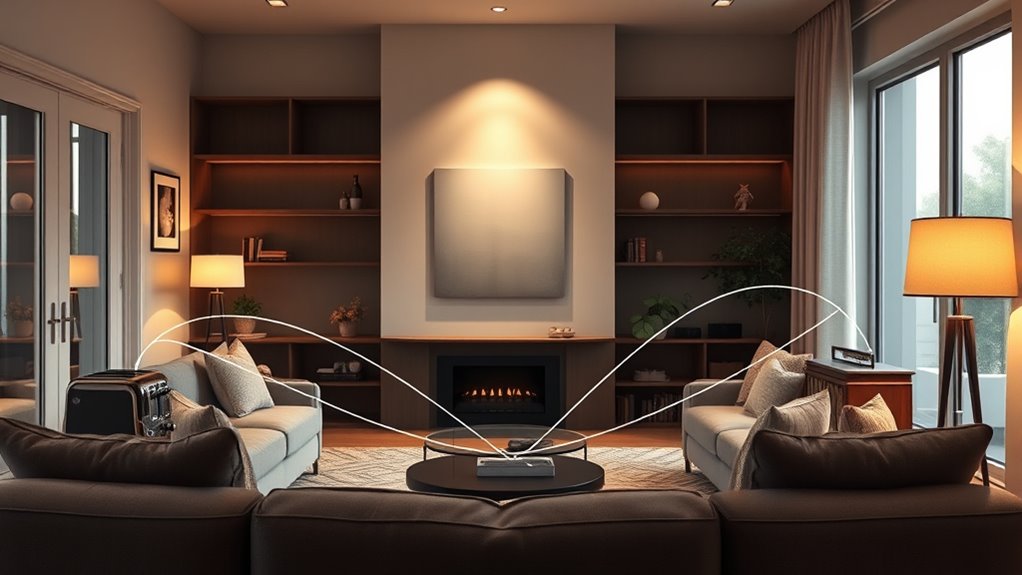
Many common smart home devices now work seamlessly with Matter bridges, enabling you to integrate legacy equipment into modern ecosystems effortlessly. Popular smart speakers and hubs, like Apple’s HomePod, Apple TV 4K, Google Nest Hub, and Amazon Echo, support Matter and Thread, facilitating smooth voice control and automation. Sensors such as door/window, motion, water leakage, and temperature sensors are compatible, helping you monitor your home effectively. You can also connect switches, dimmers, thermostats, smoke alarms, and fan controllers via Matter bridges. Lighting devices, including smart bulbs, strip lights, and dimmers, communicate over Thread or Wi-Fi for easy control. Additionally, appliances like dishwashers and air conditioners, along with closure devices such as door locks and window coverings, can be integrated, broadening your smart home capabilities. Compatibility with various protocols ensures a wider range of devices can be interconnected and managed through Matter bridges. Furthermore, the automation potential of these devices is enhanced by the interoperability enabled through Matter, making smart home management more streamlined and accessible.
Challenges Faced When Integrating Legacy Devices
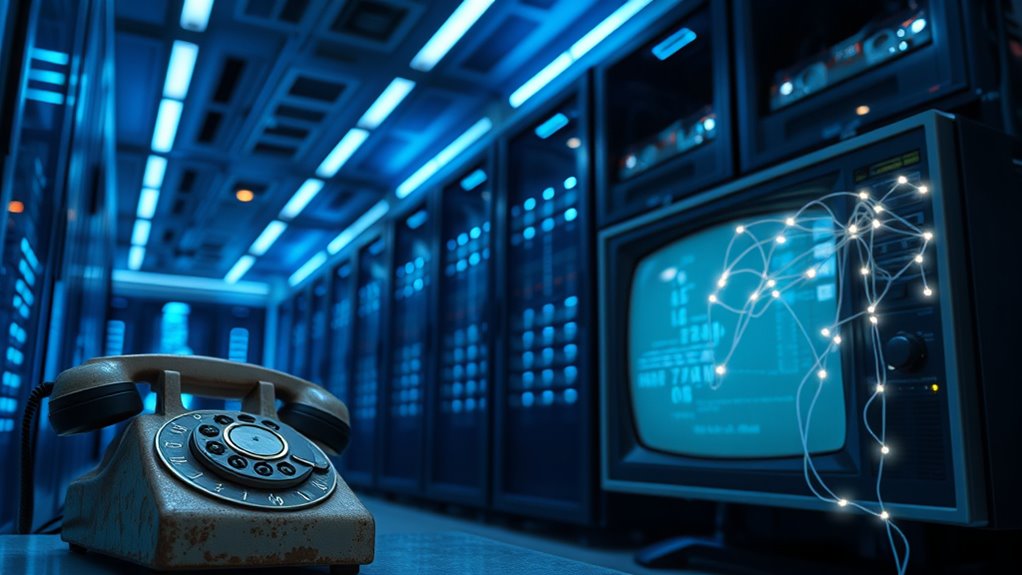
Integrating legacy devices into Matter ecosystems often brings compatibility issues and inconsistent performance across platforms. You might find setup processes complex and maintenance ongoing, especially as firmware updates and protocol translations are required. These challenges can lead to unreliable operation and a frustrating user experience. Additionally, addressing compatibility issues often requires technical knowledge and troubleshooting skills, which can further complicate seamless integration. The variability in device firmware support can also cause unexpected malfunctions and delays in updates, undermining user confidence.
Compatibility Limitations and Variances
Compatibility limitations arise because Matter bridges often deliver inconsistent functionality across different ecosystems, making it difficult to rely on legacy devices to perform all their original features. You might find that a device’s temperature or humidity readings work on Apple or Google platforms but are hidden or incomplete on Alexa or SmartThings. Power monitoring and advanced features may be lost when bridging through some ecosystems, like Alexa. Ecosystem-specific “Works with” certifications are often needed for full functionality. You may also encounter challenges such as:
- Partial or missing device features across platforms
- Inconsistent support for advanced functionalities
- Incomplete device telemetry or data presentation
- Variability in feature availability based on the ecosystem
- Additional certifications required for full compatibility
These variances mean you can’t always expect seamless performance from your legacy devices via Matter bridges. Additionally, the compatibility limitations can become more pronounced when integrating older or less common devices that lack broad ecosystem support. The device-specific support may also vary depending on firmware updates or manufacturer implementations, further complicating integration.
Setup Complexity and Maintenance
Setting up legacy devices through Matter bridges can be more complicated than expected due to the diverse implementations across ecosystems. Different platforms like Apple, Google, Amazon, and SmartThings handle device integration uniquely, causing inconsistent visibility and control. When commissioning multiple devices at once, you might find devices misidentified or require vendor-specific apps to gain access to full features. The presence of several ecosystem hubs complicates the setup, especially when managing multi-admin control. Legacy bridges for Zigbee or Z-Wave add another layer of configuration, reducing simplicity. Maintenance is also challenging; network drops often need manual rebooting, and firmware updates usually require vendor apps, not the ecosystem’s. Limited diagnostics and feature loss further complicate ongoing management, making maintenance less straightforward than with native devices. Additionally, the lack of standardized interoperability protocols can hinder seamless device communication and troubleshooting. Moreover, compatibility issues may arise due to varying implementation standards, complicating future upgrades or integrations.
Innovations and Future Trends in Matter Bridge Development
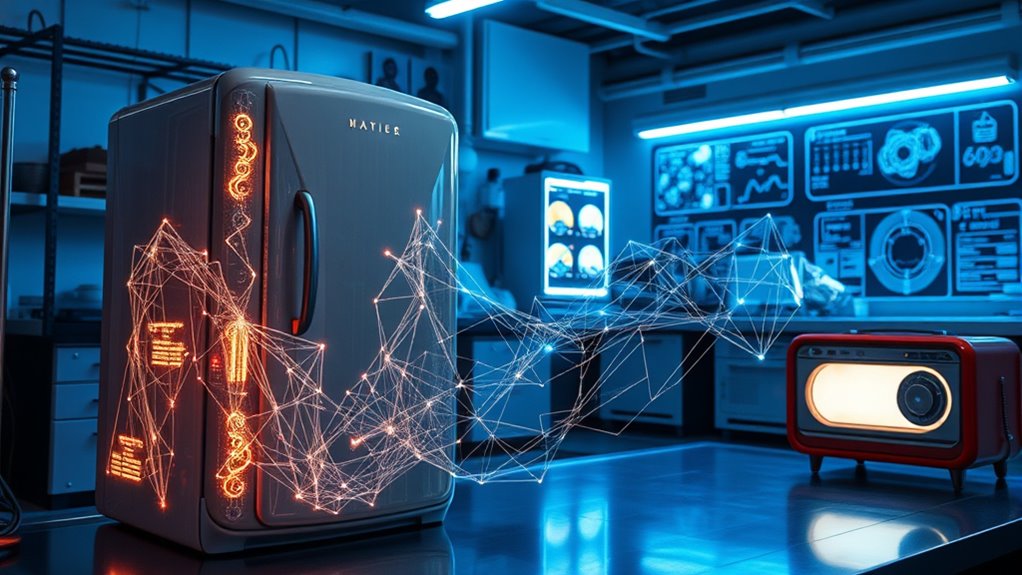
Future innovations in Matter bridge development are focusing on enhanced compatibility standards to guarantee seamless integration across diverse protocols. AI-driven optimization will enable bridges to adapt dynamically, improving performance and energy efficiency. Additionally, modular hardware designs will allow for easier upgrades and customization, keeping your smart home setup flexible and future-proof. Embracing self-awareness in design approaches can further optimize user experience and system harmony. Incorporating future-proofing strategies can also ensure the longevity and adaptability of these technologies as new standards emerge.
Enhanced Compatibility Standards
Recent advances in Matter bridge development are considerably enhancing protocol integration capabilities, allowing legacy devices like Zigbee, Z-Wave, and Bluetooth to work seamlessly within the Matter ecosystem. These bridges act as translators, converting proprietary protocols into the standard, ensuring backwards compatibility without hardware replacement. These improvements also facilitate interoperability with diverse protocols, making smart home ecosystems more flexible and user-friendly. Future efforts focus on expanding supported protocols and refining translation layers to reduce latency and improve functionality. Support for emerging standards like Thread and Wi-Fi coexistence is prioritized to optimize network performance and coverage. Developers are also exploring dynamic protocol switching to enable smoother device connectivity and a better user experience. Understanding protocol support is crucial for grasping how these advancements will shape future smart home connectivity.
- Broader protocol support, including new wireless standards
- Reduced latency through improved translation layers
- Dynamic protocol switching for seamless connectivity
- Enhanced interoperability with multiple device types
- Continued security enhancements for reliable operation
AI-Driven Bridge Optimization
AI-driven bridge optimization is revolutionizing how legacy appliances connect within the Matter ecosystem by leveraging advanced technologies like edge computing and IoT platforms. You can now use AI to modernize legacy systems without complete replacements, enabling real-time collaboration and smarter decision-making. AI helps break down data silos, making data more accessible and integrated, while facilitating API use in systems that previously lacked it. Edge computing translates legacy protocols into compatible formats, ensuring seamless integration. IoT platforms create an abstract layer for data collection, and digital retrofitting installs sensors without manual intervention. By generating metadata and establishing interoperability standards, these innovations improve connectivity and functionality. Additionally, ongoing advancements in skincare technology are paving the way for smarter, more effective solutions to skin concerns. As a result, you’ll experience enhanced efficiency, better data management, and a smoother connection toward smarter, AI-enabled appliances within the Matter ecosystem. Furthermore, legacy protocol translation is key to ensuring compatibility across diverse devices and systems, fostering a more unified smart home environment.
Modular Hardware Innovations
Modular hardware innovations are transforming how legacy devices connect within the Matter ecosystem by enabling flexible, scalable, and easy-to-implement bridge solutions. These innovations utilize stand-alone and host-based multiradio modules that combine Wi-Fi, Bluetooth Low Energy, and Thread, supporting diverse connectivity needs. Pre-certified modules from chipset partners accelerate development, ensuring compliance and reliability. Flexible antenna configurations and LTE filtering improve performance in complex environments. By supporting standards like Wi-Fi 6, Bluetooth 5.4, and 802.15.4, these modules future-proof your smart home setup. Additionally, device virtualization and middleware enable seamless integration without extra cloud or hardware, simplifying user experience. This modular approach reduces development time, enhances upgrade options, and broadens device ecosystems.
- Plug-and-play solutions for legacy device integration
- Multi-protocol support with flexible modules
- Rapid development with pre-certified components
- Enhanced wireless performance in complex environments
- Future-proof standards supporting IoT growth
Practical Tips for Setting Up and Maintaining Bridges
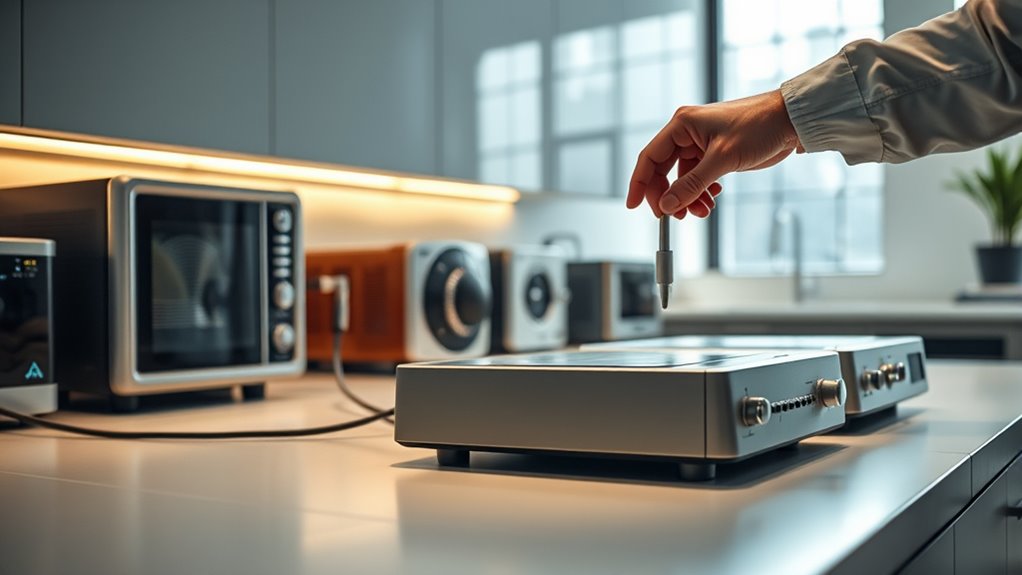
Setting up and maintaining Matter bridges requires careful attention to detail to guarantee seamless integration of legacy devices. Begin by enabling the Matter Bridge feature through your device or platform-specific interface, like the eWeLink app. Use QR codes or similar scanning methods for quick pairing with your smart home hub, such as Apple HomeKit. Confirm that your hosting system supports necessary environments like Node.js or Docker before installation. Ensure your bridge device and hub are on the same Wi-Fi network with internet access for security validation. Keep all firmware and software updated to avoid compatibility issues. Regularly check for device firmware updates, monitor network security, and utilize automation features to optimize performance. Reset and re-pair devices if problems occur, and always secure your credentials to protect your ecosystem. Additionally, understanding essential oils can help in creating a more comfortable and healthful environment in your smart home.
Frequently Asked Questions
What Are the Main Cost Considerations for Implementing Matter Bridges?
When implementing Matter bridges, you should consider hardware costs for the bridge device and any additional sensors or controllers needed. Don’t forget integration expenses like setup, testing, and staff training. Operational costs include ongoing maintenance, updates, and troubleshooting. Also, factor in vendor or licensing fees and potential downtime during installation. These costs add up, so plan your budget carefully for a smooth shift to Matter-compatible systems.
How Do I Troubleshoot Connectivity Issues With My Matter Bridge?
Think of your Matter bridge as a traffic controller—if signals or routes are blocked, communication stalls. To troubleshoot, verify IPv6 setup, confirm ports like 5353 are open, and make sure mDNS forwarding. Reboot devices, clear caches, and check logs for errors. Test responsiveness with control apps, and update firmware to prevent bugs. If devices stay offline, re-pair or restart hubs to restore smooth, reliable connections.
Are There Security Risks Associated With Using Third-Party Bridges?
Yes, there are security risks with third-party bridges. They often rely on your home router, which might have outdated settings or vulnerabilities. If compromised, a bridge can give hackers access to your entire network. Additionally, weak passcodes, insecure firmware, or poor design can lead to unauthorized device control or data breaches, putting your privacy and safety at risk. Always choose reputable brands and keep devices updated to minimize these threats.
Can I Integrate Multiple Protocols With a Single Matter Bridge?
Yes, you can integrate multiple protocols with a single Matter bridge—it’s like creating a universal translator for your smart home! This bridge supports Zigbee, BLE, Thread, and Z-Wave simultaneously, making your devices speak one common language. It seamlessly translates commands, so your devices work together effortlessly under one controller. Imagine managing all your smart devices from different protocols with just one simple, unified interface—it’s a game-changer!
How Often Should Firmware Updates Be Performed on Matter Bridges?
You should perform firmware updates on your Matter bridges whenever new updates are available, especially security patches, feature enhancements, or compatibility improvements. Since updates are released as needed and not on a fixed schedule, it’s best to check periodically—sometimes weekly or monthly—and enable automatic updates if possible. Staying current guarantees your devices stay secure, work smoothly with new devices, and support the latest protocol features.
Conclusion
So, now you’re basically the maestro of your smart home symphony, wielding matter bridges like a tech wizard. Just remember, these tiny magic gateways might not fix all your old appliances’ stubborn quirks overnight, but hey, they sure make you look like a futuristic genius. Keep tinkering, stay curious, and soon your legacy devices will be dancing seamlessly with the latest protocols—who knew aging appliances could finally get their moment in the smart spotlight?
